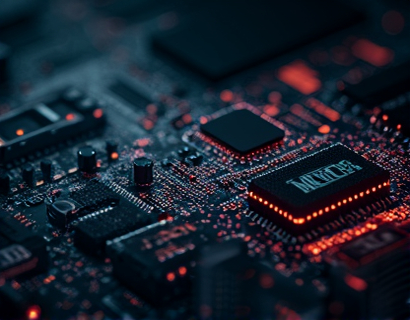DeFi Trading Elevated: Mastering Automated Market Makers for Optimal Automation and Liquidity
In the rapidly evolving world of decentralized finance, or DeFi, traders and enthusiasts are constantly seeking ways to enhance their trading experiences. One of the most transformative tools in this space is the Automated Market Maker, or AMM, particularly when leveraged through advanced smart-contract technology. This article delves into the intricacies of using AMMs for optimal automation and liquidity, exploring how these tools can revolutionize decentralized trading.
AMMs have become a cornerstone of the DeFi ecosystem, offering a decentralized alternative to traditional order books. Unlike conventional trading platforms, AMMs use liquidity pools and mathematical formulas to determine prices and execute trades. This approach not only enhances liquidity but also provides a more transparent and fair trading environment. For crypto traders and DeFi enthusiasts, mastering AMMs is essential to stay competitive and efficient in the market.
Understanding Automated Market Makers
At its core, an AMM operates by maintaining a constant product of liquidity tokens within a pool. The most common formula used is x * y = k, where x and y represent the amounts of two assets in the pool, and k is a constant. When a trader wants to exchange assets, the AMM recalculates the amounts of each asset based on the current values, ensuring the product remains constant. This mechanism eliminates the need for a traditional order book and reduces the risk of slippage, especially in low-liquidity scenarios.
The beauty of AMMs lies in their ability to provide continuous market access without the need for human intervention. Liquidity providers (LPs) deposit assets into a pool, earning liquidity fees as a reward. Traders can then interact with the pool to buy or sell assets based on the current prices determined by the AMM. This setup not only enhances liquidity but also democratizes trading, allowing participants to engage in decentralized markets.
Optimizing Liquidity Management with AMMs
One of the primary advantages of using AMMs is the optimized liquidity management they offer. Traditional trading platforms often suffer from liquidity issues, particularly for lesser-known assets. AMMs mitigate this problem by maintaining a constant pool of liquidity, ensuring that trades can be executed smoothly even for low-volume tokens. This is particularly beneficial for DeFi projects aiming to attract a broader user base and enhance their ecosystem's utility.
To maximize the benefits of AMMs, traders should focus on selecting liquidity pools with high trading volumes and low volatility. High-volume pools offer better liquidity and tighter spreads, reducing the cost of trading. Additionally, pools with stable asset pairs tend to be more attractive, as they minimize the risk of significant price fluctuations. By carefully choosing which pools to participate in, traders can optimize their liquidity management and enhance their overall trading efficiency.
Automating Trading Strategies with Smart Contracts
Smart contracts, the backbone of AMMs, enable the automation of complex trading strategies. These self-executing contracts with the terms directly written into code can automate a wide range of trading activities, from simple buy and hold strategies to sophisticated arbitrage and hedging tactics. By leveraging smart contracts, traders can execute trades 24/7 without the need for intermediaries, reducing costs and increasing speed.
One of the most powerful features of smart contracts in AMMs is their ability to implement algorithmic trading. Traders can program their smart contracts to automatically execute trades based on predefined conditions, such as price movements or market depth. This level of automation not only saves time but also allows for more consistent and disciplined trading, reducing the impact of emotional decision-making.
For instance, a trader can create a smart contract that monitors the price of a specific token and automatically buys it when the price drops below a certain threshold and sells it when it rises above another level. This strategy, known as mean-reversion trading, can be highly effective in volatile markets. By automating such strategies, traders can capitalize on market inefficiencies and generate consistent returns.
Enhancing Market Interactions with Advanced AMM Features
Modern AMMs offer a range of advanced features that further enhance market interactions and trading experiences. One such feature is the implementation of yield farming, which allows liquidity providers to earn additional rewards by staking their tokens in specific pools. This incentivizes more participants to contribute liquidity, thereby increasing the overall liquidity and depth of the market.
Another advanced feature is the use of governance tokens, which grant holders voting rights to propose and vote on changes to the AMM protocol. This decentralized governance model ensures that the AMM evolves in line with the community's needs, fostering a more resilient and adaptive ecosystem. Traders and liquidity providers can actively participate in shaping the future of the platform, making it more user-friendly and efficient.
Moreover, some AMMs incorporate oracle services to provide real-time price data, ensuring that the AMM's price calculations are as accurate as possible. This is crucial for maintaining fair and transparent trading conditions, especially in a decentralized environment where trust is paramount. By integrating reliable oracles, AMMs can reduce the risk of price manipulation and enhance the overall trading experience.
Challenges and Considerations
While AMMs offer numerous advantages, they also come with their own set of challenges and considerations. One of the primary concerns is the impermanent loss that liquidity providers may face. When asset prices fluctuate, the value of the liquidity provider's tokens in the pool can differ from the value of the tokens they would have held outside the pool. This risk is particularly significant in highly volatile markets, and traders should carefully assess their risk tolerance before participating in liquidity pools.
Another consideration is the complexity of smart contracts. While they offer powerful automation capabilities, they can also be vulnerable to bugs and security issues. It is crucial for users to thoroughly research and audit the smart contracts they interact with to ensure their safety and reliability. Using well-vetted and community-supported AMMs can mitigate these risks.
Additionally, the decentralized nature of AMMs means that users must manage their own funds and private keys. This level of control offers greater freedom but also requires a higher degree of technical knowledge and responsibility. Traders should ensure they have a solid understanding of blockchain technology and best practices for secure asset management.
Future Trends in DeFi Trading
As the DeFi landscape continues to mature, we can expect significant advancements in AMM technology and its applications. One emerging trend is the integration of machine learning algorithms to enhance price prediction and trading strategy optimization. By leveraging AI, AMMs can become even more intelligent, adapting to market conditions in real-time and providing more accurate price assessments.
Another area of growth is the cross-chain interoperability of AMMs. As more blockchain networks become interconnected, AMMs can facilitate seamless trading across different ecosystems, expanding liquidity and access to a global user base. This will not only enhance the utility of DeFi platforms but also drive innovation and adoption.
Furthermore, the rise of layer 2 solutions and scalability protocols will play a crucial role in improving the performance and cost-efficiency of AMMs. By offloading transactions to secondary layers, AMMs can process more trades with lower fees, making decentralized trading more accessible and appealing to a wider audience.
Conclusion
Mastering Automated Market Makers is essential for anyone looking to optimize their trading experience in the DeFi space. By understanding the fundamentals of AMMs, optimizing liquidity management, automating trading strategies, and leveraging advanced features, traders can navigate the dynamic crypto landscape with greater efficiency and confidence. As the DeFi ecosystem continues to evolve, AMMs will remain a pivotal component, driving innovation and enhancing the overall trading experience.











































